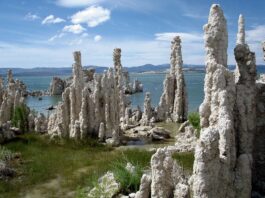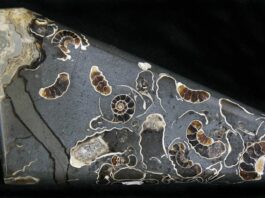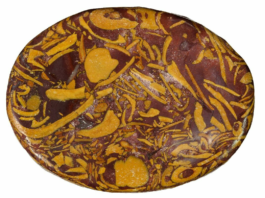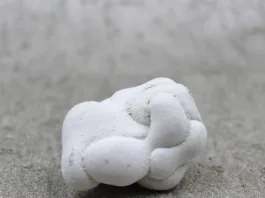Mudstone is a type of sedimentary rock that is characterized by its fine-grained nature and is composed primarily of silt- and clay-sized particles. It is one of the most common sedimentary rocks and plays a significant role in the field of geology.

Mudstone is a sedimentary rock that forms from the consolidation of mud, which is composed of a mixture of clay minerals, silt-sized particles, and other organic material. The particles in mudstone are typically too small to be individually seen with the naked eye, and the rock often has a smooth, dense appearance. Mudstone differs from shale in that it lacks the fissility (ability to split into thin layers) that is characteristic of shale.
Contents
Importance in Geology
- Sedimentary Record: Mudstone is a crucial component of the sedimentary record, preserving information about past environmental conditions, climate changes, and the evolution of life on Earth. The fine-grained nature of mudstone allows it to capture and retain detailed sedimentary structures and microfossils, making it a valuable archive for geologists studying Earth’s history.
- Source of Natural Resources: Mudstones can be associated with the formation of important natural resources. For example, certain mudstone deposits may be rich in organic material and contribute to the formation of hydrocarbons like oil and natural gas. Understanding the composition and structure of mudstone is essential for the exploration and extraction of these valuable resources.
- Geotechnical Considerations: Mudstone can have important geotechnical implications, especially in construction and civil engineering projects. Understanding the properties of mudstone, such as its strength, porosity, and compaction characteristics, is vital for assessing the stability of the ground and designing foundations for structures.
- Environmental Indicators: Mudstone can serve as an environmental indicator. Changes in the composition and structure of mudstone layers can provide insights into past environmental conditions, such as variations in sea level, sedimentation rates, and the presence of specific types of organisms.
- Research in Paleoclimatology: Mudstone deposits often contain isotopic and geochemical signals that can be used to reconstruct past climates. By studying mudstone formations, geologists can gain insights into ancient climate patterns, helping to refine our understanding of Earth’s climatic history.
In summary, mudstone is a fundamental component of the Earth’s geological processes, acting as a recorder of Earth’s history and providing valuable information for various scientific disciplines, including paleontology, paleoclimatology, and resource exploration.
Composition of Mudstone

Mudstone is composed primarily of fine-grained particles, with clay minerals and silt-sized particles being the dominant constituents. The specific composition of mudstone can vary, but the following components are commonly found:
- Clay Minerals:
- Kaolinite: A common clay mineral that forms from the weathering of aluminum-rich minerals.
- Illite: A clay mineral belonging to the mica group.
- Smectite: Includes minerals like montmorillonite and beidellite, known for their expandable properties.
- Silt-sized Particles:
- Silt: Fine-grained sedimentary particles, larger than clay but smaller than sand.
- Organic Material:
- Decomposed organic matter, including plant debris and microorganisms, can be present in mudstone.
- Quartz:
- Feldspar:
- Depending on the source rock, mudstone may contain feldspar minerals, such as orthoclase and plagioclase.
- Calcite or Dolomite:
- Mudstones may contain carbonate minerals like calcite or dolomite, particularly if the sediment was influenced by marine or freshwater conditions.
- Iron Oxides:
- Phyllosilicates:
- Minerals with a sheet-like structure, including chlorite and serpentine, may be present.
- Trace Minerals:
- Various trace minerals may be found, depending on the geological context of the mudstone.
The precise composition of mudstone can vary based on factors such as the source rock, depositional environment, and diagenetic processes (changes that occur after sediment deposition). Mudstone often undergoes compaction and cementation over time, leading to the formation of a solid rock with a fine-grained texture. The presence of specific minerals and the overall composition of mudstone can provide important clues about the geological history and conditions in which it formed.
Characteristics of Mudstone

Mudstone exhibits several characteristics that distinguish it as a type of sedimentary rock. These characteristics are a result of its fine-grained composition and the processes that lead to its formation. Here are some key characteristics of mudstone:
- Fine-Grained Texture:
- Mudstone has a fine-grained texture, with particles that are smaller than 0.0625 mm (classified as clay and silt-sized). The fine nature of the particles contributes to a smooth and often dense appearance.
- Lack of Fissility:
- Unlike shale, another fine-grained sedimentary rock, mudstone typically lacks fissility. Fissility refers to the ability of a rock to split into thin layers along closely spaced planes. Mudstone tends to break into irregular or blocky fragments rather than thin, flat layers.
- Smooth Surface:
- The surface of mudstone is often smooth, and the rock may have a slightly shiny appearance due to the presence of clay minerals.
- Color Variability:
- Mudstone can exhibit a range of colors, including gray, brown, red, green, and black. The color is influenced by the mineral composition, the presence of organic material, and diagenetic processes.
- Compacted Structure:
- Mudstone forms through the compaction and cementation of fine-grained sediment. The particles are closely packed together, and over time, pressure and mineral cementation transform the loose sediment into a solid rock.
- Preservation of Sedimentary Structures:
- Mudstone is known for preserving sedimentary structures and features, such as ripple marks, mud cracks, and bedding. These structures provide valuable information about the depositional environment and processes.
- Source of Microfossils:
- Mudstone is often rich in microfossils and other microscopic remains of organisms. The fine-grained matrix preserves these delicate structures, making mudstone a valuable resource for paleontologists studying ancient life forms.
- Water Absorption:
- Mudstone has a tendency to absorb water, and its physical properties can be influenced by changes in moisture content. This can have geotechnical implications, particularly in construction and engineering.
- Commonly Associated with Shale:
- Mudstone is closely related to shale, another fine-grained sedimentary rock. The distinction between the two lies in the lack of fissility in mudstone compared to the pronounced layering of shale.
- Environmental Indicators:
- Mudstone layers often provide clues about past environmental conditions, including variations in sea level, climate changes, and the nature of the depositional basin.
Understanding these characteristics helps geologists interpret the geological history, depositional conditions, and environmental changes recorded in mudstone formations. The rock’s fine-grained nature and its ability to preserve detailed features make it a valuable tool for reconstructing Earth’s past.
Formation of Mudstone

The formation of mudstone involves a series of geological processes that transform loose sediment into a solid rock. The following steps outline the typical sequence of events in the formation of mudstone:
- Weathering and Erosion:
- The process begins with the weathering of pre-existing rocks. Weathering breaks down rocks into smaller particles through physical, chemical, and biological processes. These particles, including clay minerals, silt, and other fine-grained materials, are then transported by wind, water, or ice.
- Transportation:
- The weathered particles are transported by agents such as rivers, wind, or ocean currents. During transportation, the finer particles, including clay and silt, are carried over longer distances, while coarser particles may settle more quickly.
- Deposition:
- As the transporting agents lose their energy, the suspended particles settle out of the fluid and accumulate in a depositional basin. This can occur in environments such as river deltas, lakes, coastal areas, or deep marine settings. The accumulation of fine-grained sediment forms a layer known as mud.
- Compaction:
- Over time, the weight of overlying sediment and the process of compaction squeeze the mud, reducing the pore spaces between particles. This compaction is a key factor in transforming loose sediment into a more solid form.
- Cementation:
- As sediment becomes compacted, minerals dissolved in pore water can precipitate and act as cement, binding the particles together. Common cementing minerals in mudstone include silica, calcite, or iron minerals. Cementation further solidifies the sediment, turning it into a coherent rock.
- Diagenesis:
- Mudstone undergoes diagenesis, which refers to all the physical, chemical, and biological changes that occur after sediment is deposited but before it undergoes metamorphism. Diagenetic processes can include mineral alteration, the formation of new minerals, and the development of sedimentary structures.
- Preservation of Sedimentary Structures:
- Mudstone has the ability to preserve sedimentary structures and features, such as bedding, ripple marks, and mud cracks. These structures provide valuable information about the conditions at the time of deposition.
- Organic Matter Accumulation:
- In some cases, mudstone may accumulate organic matter, such as plant debris or microorganisms. This organic material can become incorporated into the rock, contributing to its composition.
The specific characteristics of mudstone, including its color, texture, and mineral composition, depend on factors such as the source rock, the nature of the depositional environment, and subsequent diagenetic processes. Mudstone is a common sedimentary rock that plays a significant role in preserving Earth’s geological history and environmental conditions.
Types of Mudstones

Mudstone encompasses various types and classifications based on specific characteristics, depositional environments, and mineral compositions. Some common types of mudstones include:
- Shale:
- Shale is a type of mudstone that exhibits fissility, meaning it can easily split into thin layers. It is characterized by its laminated appearance and is often rich in clay minerals. Shale is commonly found in marine environments but can also form in lakes and other depositional settings.
- Claystone:
- Claystone is a type of mudstone dominated by clay minerals. It lacks the fissility of shale and tends to break into blocky or irregular fragments. The term “claystone” is often used when the rock has a higher clay content compared to silt.
- Siltstone:
- Siltstone is a fine-grained sedimentary rock with a higher proportion of silt-sized particles compared to clay. It is coarser than mudstone and typically lacks the plasticity associated with clay-rich rocks. Siltstone may also contain some clay and other minerals.
- Argillite:
- Argillite is a low-grade metamorphic rock that forms from the metamorphism of mudstone or shale. It retains a fine-grained texture and often displays a slaty cleavage. The term “argillite” is sometimes used interchangeably with mudstone or shale.
- Marl:
- Marl is a type of mudstone that contains a significant proportion of calcium carbonate (calcite or dolomite). It forms in environments where carbonate minerals accumulate, such as shallow marine or lacustrine settings. Marl can have a variable composition, ranging from clay-rich to carbonate-rich.
- Black Shale:
- Black shale is a type of shale that has a dark color due to the presence of organic material, typically derived from the remains of marine plankton. The organic content can contribute to the formation of hydrocarbons, making black shale of interest in petroleum source rock studies.
- Green Claystone:
- Green claystone gets its color from the presence of minerals like chlorite or other green-colored clay minerals. The green hue can be indicative of reducing conditions during deposition.
- Red Mudstone:
- Red mudstone gets its color from the presence of iron oxide minerals, such as hematite or goethite. The red color suggests oxidizing conditions during deposition and may indicate a terrestrial or well-aerated marine environment.
- Calcilutite:
- Calcilutite is a fine-grained limestone composed mainly of carbonate mud. It can be considered a carbonate equivalent of mudstone, with a significant proportion of mud-sized carbonate particles.
The classification of mudstones can sometimes be challenging due to the overlapping nature of these categories. The specific type of mudstone encountered in a particular location depends on factors such as the depositional environment, source rock, and diagenetic processes. Researchers and geologists use these classifications to better understand the characteristics, origins, and geological significance of different mudstone types.






